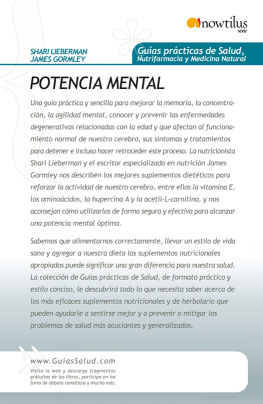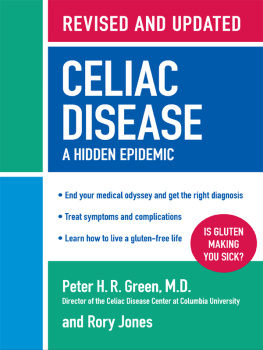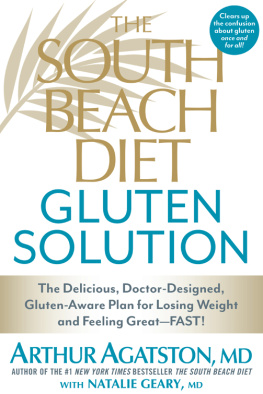

To my husband, Augusto,
whose love and support
make monumental tasks
so much easier.
CONTENTS
FOREWORD
When Dr. Shari Lieberman asked me to write the foreword to her book on gluten sensitivity, I paused to think for a moment: Im a specialist in matters of the heart, not gastrointestinal (GI) disease.
But in addition to being a cardiologist, I am a certified nutrition specialist, and so I am deeply entrenched in the dietary and nutritional issues of my patients. Combining a healthy diet with essential targeted nutrition is perhaps the most important way to prevent disease. Certainly in my specialty (preventive and metabolic cardiology), the Mediterranean diet has proven to be the healthiest dietary approach for preventing sudden cardiac death, as well as for reducing the incidence of subsequent cardiac events. The Mediterranean diet provides an abundance of precious omega-3 essential fatty acids that have a profound impact in reducing inflammation.
Silent inflammation as we know it today is the main factor in the development of cardiovascular disease, gastrointestinal problems, diabetes, cancer, Parkinsons disease, and other neurodegenerative diseases. Although the many causes of silent inflammation include cigarette smoking, heavy metals, microbes, trans fatty acids, and excessive radiation, dietary factors that cause surging insulin levels appear to top the list.
And then, of course, there are the insidious food allergies and intolerances and leaky gut type syndromes that cause immune-system dysfunctions that can slowly undermine our health.
I can attest to the fact that problems with indigestion, food allergies, malabsorption, and excessive gas and bloating do, indeed, affect the heart. So, it is not uncommon for someone like me to be intrigued by Dr. Liebermans book. I see multiple cardiovascular issues, such as heart irregularities, atypical chest pain, and high blood pressure, in people with digestive problems. And, of course, there is the complex issue of gluten sensitivity, which can develop into celiac disease (CD).
Dr. Liebermans book is about a condition that is reaching epidemic proportions. Although this malabsorption syndrome was first identified way back in 1888, it is now believed that it may be the most common genetic disorder that sends people like you, looking for answers and relief, to health-care practitioners like me.
While many readers may be wondering what Im leading up to, those of you diagnosed with this health-threatening disorderor who know someone who ishave probably figured out that I am referring to celiac disease. Dont worry if you havent heard of this problem, because thats how uninformed the general public and some medical professionals still are about CD.
This disorder is not a food allergy; it is an intolerance. The condition is also known by other multiple namessuch as gluten-sensitive enteropathy, celiac sprue, nontropical sprue, and Gee-Herters disease/syndrome.
Regardless of what label it carries, the problem is consistent: an inability to tolerate the gluten found in wheat, barley, and rye, with or without damage to the villi of the jejunum (upper part of the small intestine). The villi are microscopic, hairlike projections in the small intestine that provide the surface area needed to absorb the nutrients from the foods and supplements you ingest.
The link between this disease and diet wasnt made until 1944, when a Dutch pediatrician observed that children in his clinic started getting better after the Nazi invasion. Symptoms such as bloating, stomach cramping, diarrhea, and generalized fatigue gradually abated as bread disappeared from their diets, even though the children were starving for food.
Despite recent public awareness campaigns, most doctors think CD is a low-incidence problem. And most doctors think only in terms of celiac diseasethe ultimate form of gluten sensitivity.
CD can be, and is, diagnosed at any age, from infancy to the last decade of life, but it may take up to 10 years of symptoms for that to happen in the United States, while the typically affected European is diagnosed by more CD-conscious doctors within a year, on average.
I remember one of my patients, a Catholic nun who was diagnosed as having CD in her late 80s, after years of becoming ill after ingesting the communion wafer. The small amount of gluten in the wafer caused her to develop gas, bloating, and diarrhea. Unfortunately, she suffered for an enormous length of time before someone finally diagnosed her problem.
One year, 10 years, or any chunk of your life is a long time to suffer when no one knows what is wrong with you. Dr. Liebermans book raises public awareness about this terrible condition that afflicts many peoplesome genetically predisposed, some not. One person in the latter category (not genetically predisposed) is my own son Step, who developed acquired celiac disease after being exposed to toxic molds.
As you can imagine, when my own grown child complained of GI symptoms of bloating, diarrhea, and gas, along with a 40- to 50-pound weight loss, I became concerned. I took him to more than a dozen top doctors and specialists across the country, but the puzzle pieces didnt fall into place. He even went to the Mayo Clinic and saw specialists in endocrinology and neurology and had a muscle biopsy done by the general surgery service.
Although laboratory tests showed multiple laboratory abnormalities, a diagnosis was still uncertain. Finally, he found a physician-expert in environmental biotoxins, who diagnosed him with acquired gliadin allergy.
CD responds well when glutenthe trigger food-product ingredientis removed from the diet. Now, Im sure that many people are still undiagnosed and are still suffering, totally unaware about this bizarre form of acquired CD. But people with CD who continue to eat gluten risk tremendous health consequences, including a host of medical and autoimmune disorders and a higher risk of bowel cancer.
Furthermore, the longer they go undiagnosed, the more damage occurs to their intestines and the rest of their body. Clearly, when my son Step takes in any gluten, his health takes a step backward. Even though he does not have genetically predetermined CD, the acquired type of CD that he does have still requires the elimination of gluten from his diet.
Whenever making the diagnosis is obscure or difficult for mewhether Im treating heart disease, psoriasis, GI symptoms, or whateverIve found that having the individual restrict or eliminate gluten from the diet has resulted in spontaneous improvement. The prescription to eliminate gluten even in the case of cardiomyopathy is well founded on science. Dr. Lieberman, in fact, cites published studies that show the beneficial effects of a gluten-free diet on patients who suffer from cardiomyopathy, as well as a host of neurological, dermatological, and gastrointestinal problems.
Now, you may think that its cruel to restrict flour and wheat from someones diet for several months or even for a lifetime. But when you see the remarkable improvement in health a gluten-sensitive person gains when the offending substance is out of his or her system, all the dietary sacrifices are more than worth it!
If you were the person experiencing this for yourself and getting your life back, Im sure youd continue a gluten-free diet, just as my cardiac patients who have experienced a heart attack or gone through bypass surgery are motivated to stick to the Mediterranean or Asian-type diet that I insist they try.
Next page












